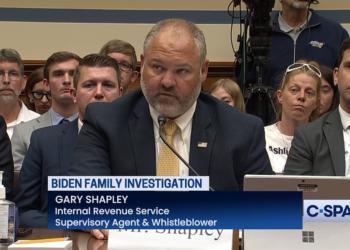The administration calls these “reciprocal tariffs,” implying that we will tax other countries’ exports to us the same way they tax our exports to them. As Trump said, “Reciprocal: That means they do it to us, and we do it to them.”
That’s not true of Trump’s tariffs.
Instead, Trump has set tariff rates that are generally proportional to our trade deficit with a given country. The implicit logic here is that the United States would have balanced trade or a surplus with every single country in the world if not for the other countries’ trade distortions.
Trump’s logic is bad, and his conclusion is worse. A good way to see the flaws in this reasoning is to look at a few of the countries Trump is tariffing.
5. South Korea, 25%
Trump announced the global tariffs on April 2, including a 25% “reciprocal” tariff on South Korea.
Flashback one month to March 1, and the Trump administration affirmed that Korea had, in Trump’s first term, eliminated almost all tariffs on the U.S.
U.S. Trade Rep. Jamieson Greer reported last month that under the 2012 U.S.-Korea Free Trade Agreement, “Korea immediately eliminated duties on nearly 80 percent of bilateral trade in industrial and consumer goods. Duties on most other such goods were phased out in stages over 10 years and have been eliminated as of January 1, 2021. Tariffs continue to be phased out for certain seafood products, which are scheduled to be eliminated in 2026. Korea has eliminated tariffs on the majority of U.S. agricultural products, while maintaining tariff-rate quotas (TRQs) on a handful of U.S. agricultural exports.”
Yes, some U.S. exporters object to some of Korea’s regulations, including its ban on U.S. beef from mature cows and its rules on car emissions controls. But Trump’s 25% tariff on all Korean exports towers over Korea’s lower tariffs, which don’t apply to a vast majority of our exports there.
There’s a geopolitics dimension here: The U.S. is just about tied for first place as Korea’s largest export market. Which market is barely larger than the U.S. for Korea?
The People’s Republic of China.
Trump’s Korea tariffs will, if they stay in place, weaken U.S.-Korea ties and strengthen Korea’s dependence on China. That is, they will strengthen China’s regional influence. Seems suboptimal!
4. Australia, 10%
So, when I said the tariffs were proportional to our bilateral trade deficit with a given country, I was being a bit imprecise. If that were strictly true, Trump would have imposed negative tariffs on Australia since we have a $17.9 billion trade surplus with the country — and it’s growing.
So where does that 10% “reciprocal tariff” come from? That’s just the arbitrary baseline minimum Trump imposed. Anyone with a trade deficit or a small trade surplus vis-à-vis the U.S. gets slapped with a 10% tariff.
Australia’s biggest export to the U.S. is beef. The U.S. does not have a surplus of beef. Since 2010, beef prices have risen by 165%, compared to an overall inflation of 46%.
Another major export from Australia is aluminum. Who buys Australian aluminum? U.S. manufacturers, including carmakers like Chevy and Ford. So, raising the cost of Australian aluminum is imposing a tax on U.S. manufacturers.
We should note, though, that Australian aluminum isn’t subject to these 10% tariffs — it is subject to Trump’s 25% tariffs.
3. Lesotho, 50%
Trump believes that countries with a trade surplus vis-à-vis the U.S. are cheating and getting rich off of us.
However, Trump has imposed his second-highest tariff rate on Africa’s poorest country.
The people of Lesotho are mostly goatherds, shepherds, or subsistence farmers. The nation’s per capita GDP is $916 a year, and it is falling. Lesotho is also completely surrounded by South Africa.
It may not surprise you to learn that Lesotho’s goatherds don’t have a large budget for importing U.S. goods. The country imported less than $3 million of U.S. goods last year. The cotton grown in Lesotho, however, becomes denim, which Americans buy. The result is a large trade imbalance, and so Trump slapped 50% tariffs on this small, impoverished country.
Trump, presumably, will keep these punitive tariffs on the people of Lesotho until they get rich enough to buy some F-150s and KitchenAid mixers.
2. Guatemala, 10%
Guatemala imports about $9 billion of goods each year from the U.S. Meanwhile, the U.S. imports about $5 billion a year from Guatemala.
That means this “reciprocal” tariff is punishing Guatemala for having a trade deficit with the U.S., again undermining the logic of the whole program.
But surely these tariffs are also about fostering domestic industry and creating reliable jobs for working-class Americans, right?
Well, this 10% Trump tariff will mostly affect bananas, Guatemala’s chief export to the U.S. Outside of Florida and Hawaii, it’s really hard to grow bananas. So we are taxing Americans’ favorite fruit, coming from a country with which we have a trade surplus and without much possibility of fostering domestic production.
TRUMP’S TRADE WAR MAY BE WON OR LOST AT HOME
1. Heard Island and McDonald Islands, 10%
Heard Island and McDonald Islands have never imported even a penny of U.S. goods. That’s because everyone who lives there is a penguin. If those penguins try to export any penguin products here, Trump will slap them with a 10% tariff.
Suck it, penguins.














